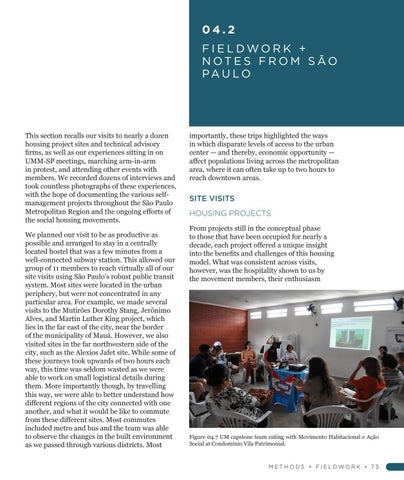04.2 FIELDWORK + N OT E S F R O M SÃO PA U LO
This section recalls our visits to nearly a dozen housing project sites and technical advisory firms, as well as our experiences sitting in on UMM-SP meetings, marching arm-in-arm in protest, and attending other events with members. We recorded dozens of interviews and took countless photographs of these experiences, with the hope of documenting the various selfmanagement projects throughout the São Paulo Metropolitan Region and the ongoing efforts of the social housing movements. We planned our visit to be as productive as possible and arranged to stay in a centrally located hostel that was a few minutes from a well-connected subway station. This allowed our group of 11 members to reach virtually all of our site visits using São Paulo’s robust public transit system. Most sites were located in the urban periphery, but were not concentrated in any particular area. For example, we made several visits to the Mutirões Dorothy Stang, Jerônimo Alves, and Martin Luther King project, which lies in the far east of the city, near the border of the municipality of Mauá. However, we also visited sites in the far northwestern side of the city, such as the Alexios Jafet site. While some of these journeys took upwards of two hours each way, this time was seldom wasted as we were able to work on small logistical details during them. More importantly though, by travelling this way, we were able to better understand how different regions of the city connected with one another, and what it would be like to commute from these different sites. Most commutes included metro and bus and the team was able to observe the changes in the built environment as we passed through various districts. Most
importantly, these trips highlighted the ways in which disparate levels of access to the urban center — and thereby, economic opportunity — affect populations living across the metropolitan area, where it can often take up to two hours to reach downtown areas.
SITE VISITS HOUSING PROJECTS From projects still in the conceptual phase to those that have been occupied for nearly a decade, each project offered a unique insight into the benefits and challenges of this housing model. What was consistent across visits, however, was the hospitality shown to us by the movement members, their enthusiasm
Figure 04.7 UM capstone team eating with Movimento Habitacional e Ação Social at Condomínio Vila Patrimonial.
METHODS + FIELDWORK • 73













